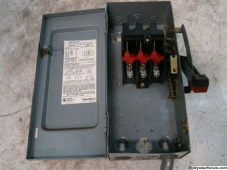ProtonWH
New Member
I'm wondering how switch ratings work. If I send higher DC voltage but lower amps for the switch is this acceptable? I'm wanting to send 300vdc at 12A through a switch rated at 48vdc and 300A...
Absolutely not...I'm wondering how switch ratings work. If I send higher DC voltage but lower amps for the switch is this acceptable? I'm wanting to send 300vdc at 12A through a switch rated at 48vdc and 300A...
Still trying to "design" a 2 inverter system where I could switch the PV from one inverter to another manually.First question is what are you trying to do and why use something not rated for it? An IMO switch/isolator is already rated for what you are trying to do.
That's the concise info I appreciate, Thanks!Absolutely not...
DC breakers are voltage SPECIFIC for arc protection.
BOTH amps and VOLTS must be adhered to.
(without buying 2 switches...) and no way for both inverters to be fed PVStill trying to "design" a 2 inverter system where I could switch the PV from one inverter to another manually.
OK, sounds like I need to find out somehow then if the two inverters I have my eye on will ac couple...Yeah, the panels COULD be isolated first, the switched, then reconnected...
The issue is BREAKING the connection under load.
So, IF you shut down panel output before you switched it would work...
If you tried switching without shutting down, you would destroy thw selector contacts, and possibly cause a fire...
Also, the insulation rating would have a dangerous situation.
200V DC is NOT something to play with.
No.Are you implying that the required for code PV isolation switch for first responders is a single or limited use if under load? Does the switch melt down trying to break that high voltage connection, even when rated to do so and a good quality brand?
No.
I am saying if you use a pv selector switch rated lower than the voltage you use, it could possibly work if you have ANOTHER switch on the pv lines that IS rated for the right voltage, turn OFF the PV THEN switch inputs, THEN turn PV back on...
BUT the insulation on the lower rated selector may expose the high PV voltage as a shock hazzard, AND if ever selected under load could be a fire hazard as well.

Why are you trying to do that?Still trying to "design" a 2 inverter system where I could switch the PV from one inverter to another manually.
Trying to figure a way to not buy a SA 15K and keep my project at $1 @ W.Why are you trying to do that?
I would simply use 250Vac 16A relays driven by electronic lockout circuit that monitors current and state of inverter AC output or in the case of all in one inverter you can monitor PV input current. Configure switching logic this way: on signal to switch over send inverter disable signal to both inverters, check PV current, if zero then send signal to switch inverter inputs. You can also add properly rated TVS diode across PV conductors to limit inductive voltage spike if you do accidentally end up switching under load but that may still arc and destroy relays. Make sure to house this switching unit inside fireproof metal box. Best route would be to go with solid state switch using high voltage mosfets but at higher complexity.Still trying to "design" a 2 inverter system where I could switch the PV from one inverter to another manually.
Trying to design at component compatibility level system that is grid tied- sell power after the second hybrid inverter charges my batteries, but if an extended outage I wanted to island with a transfer switch and switch PV over to the second hybrid off grid inverter...You could use separate independent charge controllers.
Very cool, thanks!


